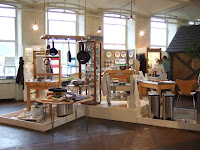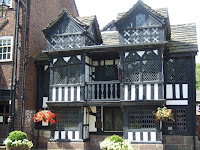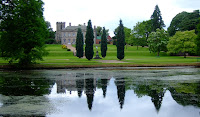 After a few fine days, summer was over once again, but despite this we headed up the A1 to visit a World Heritage Site: the village of Saltaire.
After a few fine days, summer was over once again, but despite this we headed up the A1 to visit a World Heritage Site: the village of Saltaire.Enroute, we broke the journey at Nostell Priory. In typical style, the Priory originally a real priory, passed into private ownership after the dissolution of the monasteries.
The current owners have lived there for 350 years, although it is jointly in the care of the National Trust.
 The house was built in the Italian, Palladian, style after one of the past owners went on their Grand Tour. The most interesting thing about the house is the large collection of Chippendale furniture. It was commissioned for the house, and along with all the other original furnishings, is still placed as intended, in the rooms the pieces were designed for. A previous owner was the ‘sponsor’ of the young Chippendale and this is the reason that room after room is furnished in Chippendale furniture.
The house was built in the Italian, Palladian, style after one of the past owners went on their Grand Tour. The most interesting thing about the house is the large collection of Chippendale furniture. It was commissioned for the house, and along with all the other original furnishings, is still placed as intended, in the rooms the pieces were designed for. A previous owner was the ‘sponsor’ of the young Chippendale and this is the reason that room after room is furnished in Chippendale furniture.There were many suites of furniture, the largest piece was a magnificent desk and the most expensive for it's size was a beautiful tulipwood barometer on a wall.
 In all, it is the largest collection of Chippendale furniture in the world and we would recommend this house to anyone who has an interest in furniture.
In all, it is the largest collection of Chippendale furniture in the world and we would recommend this house to anyone who has an interest in furniture.Another fascinating fact is that John Harrison grew up on the estate; his father was the estate carpenter. The house has the last of the remaining 3 entirely wooden clocks that he made. Made in 1717, it still keeps perfect time.
 The promised rain only arrived as we left and made our way to Saltaire; a town built by Victorian industrialist Titus Salt. Like the Cadbury village we visited in July, it was a model village designed to improve the lot of his workers. Saltaire, however, is much larger than Bournville with 800 houses built over 14 years.
The promised rain only arrived as we left and made our way to Saltaire; a town built by Victorian industrialist Titus Salt. Like the Cadbury village we visited in July, it was a model village designed to improve the lot of his workers. Saltaire, however, is much larger than Bournville with 800 houses built over 14 years. The mill itself has been converted into offices and one wing is a retail centre with shops (including a wonderful kitchenware shop), cafes and artworks. The first floor was entirely covered in art works by David Hockney. It was a great and extensive exhibition. Apparently David Hockney grew up locally in Bradford.
The mill itself has been converted into offices and one wing is a retail centre with shops (including a wonderful kitchenware shop), cafes and artworks. The first floor was entirely covered in art works by David Hockney. It was a great and extensive exhibition. Apparently David Hockney grew up locally in Bradford.We finished the day with a self-guided tour around the town of Saltaire.
View Larger Map









 The next village was Great Hucklow. This small village was planning their annual village gala; all the gardens were decorated and two wells dressed.
The next village was Great Hucklow. This small village was planning their annual village gala; all the gardens were decorated and two wells dressed. 























